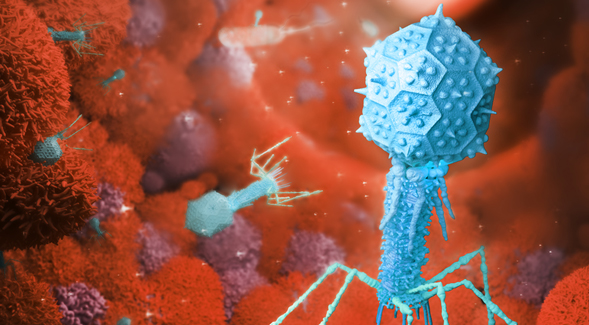Phages Dont Need Bacteria to Enter the Body
A new study led in part by SDSU scientists is the first to discover that bacteriophages can directly interact with human cells.

Bacterial viruses, known as bacteriophages, are commonplace in our bodies, inhabiting the millions and millions of bacteria that live on and inside of us. But whether these viruses hitch a ride by hiding inside invading bacteria, or enter human body cells on their own has long been a biological mystery. Now, a new study led by scientists from San Diego State University and Monash University demonstrates for the first time that bacteriophages can slip through human outer cell layers in the same way that proteins and other cellular components do.“We have known for a long time that phages are present in the blood and organs of the body, but no one has known exactly how this occurs.”
The finding “provides a mechanistic explanation for the occurrence of phages within the human body in the absence of disease,” the study’s authors write in the November/December issue of the journal mBio.
The research was led by Jeremy Barr, a biologist at Monash University in Victoria, Australia and a former postdoctoral fellow at SDSU, as well as scientists within SDSU’s Viral Information Institute (VII), including VII co-director and premier virologist Forest Rohwer and biostatisticians Antoni Luque and Barbara Bailey.
Bacteriophages are the most abundant and diverse microbes found in the body. They control and manipulate bacterial populations, prevent infection and disease and play important roles in regulating the microbiome and body.
“We have known for a long time that phages are present in the blood and organs of the body,” Barr said. “But no one has known exactly how this occurs.”
For the study, the team of researchers grew human skin cells in petri dishes and exposed them to isolated bacteriophages that had been genetically engineered to fluoresce. Watching the interaction under a powerful microscope, they were able to see the fluorescing viruses settle onto the outer layer of the skin cells and, over the course of about 10 minutes, slip through tiny vesicles that ordinarily allow in proteins and other cellular components.
“We estimate the average human body transports 30 billion phage particles from the gut into the cells, blood and organs of the body every day,” Barr said. “The fact that phages, which are foreign virus particles, are capable of freely crossing this barrier is nothing short of remarkable.”
Follow-up work will focus on how these viruses bypass the cell’s defenses that typically keep out foreign microbes, as well as what health effects—positive or negative—these bacteriophages might have once inside the body.
“What the phages are doing inside the cells, organs and systems of our bodies is a major follow-up question,” Barr said.
In January, scientists from SDSU’s VII will move their lab to the university’s new Engineering and Interdisciplinary Sciences Complex, a cutting-edge research and innovation building that encourages scientific collaboration to solve the world’s most pressing problems.



